A Toxicological Study of the Respirable Coal Mine Dust: Assessment of Different Dust Sources within the Same Mine
Abstract
1. Introduction
2. Materials and Methods
2.1. Dust Samples Collection and Preparation
2.2. Dust Characterization
2.3. Toxicological Assays
2.3.1. Batch Reactor Studies in Simulated Lung Fluids (SLFs)
2.3.2. Cell Viability Assay
2.3.3. In Vitro Immune Response and Inflammation Studies
2.4. Standards and Chemicals
2.4.1. Materials Used for Dissolution Study
2.4.2. Materials Used for In Vitro Study
3. Results and Discussion
3.1. Physicochemical Characteristics
3.2. Metal Leaching in Simulated Lung Fluids (SLFs)
3.3. In Vitro Studies on Cell Viability and Immuno Responses
4. Conclusions
Supplementary Materials
Author Contributions
Funding
Data Availability Statement
Acknowledgments
Conflicts of Interest
References
- Shekarian, Y.; Rahimi, E.; Rezaee, M.; Su, W.-C.; Roghanchi, P. Respirable Coal Mine Dust: A Review of Respiratory Deposition, Regulations, and Characterization. Minerals 2021, 11, 696. [Google Scholar] [CrossRef]
- Shangguan, Y.; Zhuang, X.; Querol, X.; Li, B.; Moreno, N.; Trechera, P.; Sola, P.C.; Uzu, G.; Li, J. Characterization of deposited dust and its respirable fractions in underground coal mines: Implications for oxidative potential-driving species and source apportionment. Int. J. Coal Geol. 2022, 258, 104017. [Google Scholar] [CrossRef]
- Cohen, R.A.; Rose, C.S.; Go, L.H.T.; Zell-Baran, L.M.; Almberg, K.S.; Sarver, E.A.; Lowers, H.A.; Iwaniuk, C.; Clingerman, S.M.; Richardson, D.L.; et al. Pathology and Mineralogy Demonstrate Respirable Crystalline Silica Is a Major Cause of Severe Pneumoconiosis in U.S. Coal Miners. Ann. Am. Thorac. Soc. 2022, 19, 1469–1478. [Google Scholar] [CrossRef]
- McPherson, M.J. Subsurface Ventilation and Environmental Engineering; Springer Science & Business Media: New Delhi, India, 2012. [Google Scholar]
- Colinet, J.; Halldin, C.N.; Schall, J. Best Practices for Dust Control in Coal Mining; US Publication No. 2021-119, IC 9532; Department of Health and Human Services, Centers for Disease Control and Prevention, National Institute for Occupational Safety and Health, DHHS (NIOSH): Pittsburgh, PA, USA, 2021.
- Scaggs, M.L. Development and Implementation of a Standard Methodology for Respirable Coal Mine Dust Characterization with Thermogravimetric Analysis; Virginia Tech: Blacksburg, VA, USA, 2016. [Google Scholar]
- Sarkar, F. Assessment of Environmental Impacts of Different Mine Unit Operations on Mine Workers and the Workplaces: A Field-Based Investigation. J. Inst. Eng. (India) Ser. D 2022, 1–14. [Google Scholar] [CrossRef]
- National Academies of Sciences, Engineering and Medicine. Monitoring and Sampling Approaches to Assess Underground Coal Mine Dust Exposure; National Academies of Sciences, Engineering and Medicine: Washington, DC, USA, 2018. [Google Scholar] [CrossRef]
- Sarver, E.; Keles, C.; Rezaee, M. Beyond conventional metrics: Comprehensive characterization of respirable coal mine dust. Int. J. Coal Geol. 2019, 207, 84–95. [Google Scholar] [CrossRef]
- Salinas, V.; Das, M.; Jacquez, Q.; Camacho, A.; Zychowski, K.; Hovingh, M.; Medina, A.; Rubasinghege, G.; Rezaee, M.; Baltrusaitis, J.; et al. Characterization and Toxicity Analysis of Lab-Created Respirable Coal Mine Dust from the Appalachians and Rocky Mountains Regions. Minerals 2022, 12, 898. [Google Scholar] [CrossRef]
- Trechera, P.; Moreno, T.; Córdoba, P.; Moreno, N.; Zhuang, X.; Li, B.; Li, J.; Shangguan, Y.; Kandler, K.; Dominguez, A.O.; et al. Mineralogy, geochemistry and toxicity of size-segregated respirable deposited dust in underground coal mines. J. Hazard. Mater. 2020, 399, 122935. [Google Scholar] [CrossRef] [PubMed]
- Brown, J.S.; Gordon, T.; Price, O.; Asgharian, B. Thoracic and respirable particle definitions for human health risk assessment. Part. Fibre Toxicol. 2013, 10, 12. [Google Scholar] [CrossRef] [PubMed]
- Shangguan, Y.; Zhuang, X.; Querol, X.; Li, B.; Li, J.; Moreno, N.; Trechera, P.; Sola, P.C.; Uzu, G. Mineralogical and geochemical variations from coal to deposited dust and toxicity of size-segregated respirable dust in a blasting mining underground coal mine in Hunan Province, South China. Int. J. Coal Geol. 2021, 248, 103863. [Google Scholar] [CrossRef]
- Assemi, S.; Pan, L.; Wang, X.; Akinseye, T.; Miller, J.D. Size Distribution, Elemental Composition and Morphology of Nanoparticles Separated from Respirable Coal Mine Dust. Minerals 2023, 13, 97. [Google Scholar] [CrossRef]
- Hettiarachchi, E.; Paul, S.; Cadol, D.; Frey, B.; Rubasinghege, G. Mineralogy Controlled Dissolution of Uranium from Airborne Dust in Simulated Lung Fluids (SLFs) and Possible Health Implications. Environ. Sci. Technol. Lett. 2018, 6, 62–67. [Google Scholar] [CrossRef] [PubMed]
- Rahman, M.; Zhao, M.; Islam, M.S.; Dong, K.; Saha, S.C. Numerical study of nano and micro pollutant particle transport and deposition in realistic human lung airways. Powder Technol. 2022, 402, 117364. [Google Scholar] [CrossRef]
- Guney, M.; Bourges, C.M.-J.; Chapuis, R.P.; Zagury, G.J. Lung bioaccessibility of As, Cu, Fe, Mn, Ni, Pb, and Zn in fine fraction (<20 μm) from contaminated soils and mine tailings. Sci. Total Environ. 2017, 579, 378–386. [Google Scholar] [PubMed]
- Kastury, F.; Smith, E.; Juhasz, A.L. A critical review of approaches and limitations of inhalation bioavailability and bioaccessibility of metal(loid)s from ambient particulate matter or dust. Sci. Total Environ. 2017, 574, 1054–1074. [Google Scholar] [CrossRef] [PubMed]
- Alpofead, J.A.H.; Davidson, C.M.; Littlejohn, D. A novel two-step sequential bioaccessibility test for potentially toxic elements in inhaled particulate matter transported into the gastrointestinal tract by mucociliary clearance. Anal. Bioanal. Chem. 2017, 409, 3165–3174. [Google Scholar] [CrossRef]
- Martin, R.; Dowling, K.; Pearce, D.; Sillitoe, J.; Florentine, S. Health Effects Associated with Inhalation of Airborne Arsenic Arising from Mining Operations. Geosciences 2014, 4, 128–175. [Google Scholar] [CrossRef]
- Fahy, J.V.; Dickey, B.F. Airway Mucus Function and Dysfunction. N. Engl. J. Med. 2010, 363, 2233–2247. [Google Scholar] [CrossRef]
- Douglas, A.N.; Robertson, A.; Chapman, J.S.; Ruckley, V.A. Dust exposure, dust recovered from the lung, and associated pathology in a group of British coalminers. Occup. Environ. Med. 1986, 43, 795–801. [Google Scholar] [CrossRef]
- Beer, C.; Kolstad, H.A.; Søndergaard, K.; Bendstrup, E.; Heederik, D.; Olsen, K.E.; Omland, Ø.; Petsonk, E.; Sigsgaard, T.; Sherson, D.L.; et al. A systematic review of occupational exposure to coal dust and the risk of interstitial lung diseases. Eur. Clin. Respir. J. 2017, 4, 1264711. [Google Scholar] [CrossRef]
- Pandey, J.K.; Agarwal, D.; Gorain, S.; Dubey, R.K.; Vishwakarma, M.K.; Mishra, K.K.; Pal, A.K. Characterisation of respirable dust exposure of different category of workers in Jharia Coalfields. Arab. J. Geosci. 2017, 10, 183. [Google Scholar] [CrossRef]
- Zosky, G.R.; Hoy, R.F.; Silverstone, E.J.; Brims, F.J.; Miles, S.; Johnson, A.R.; Gibson, P.G.; Yates, D.H. Coal workers’ pneumoconiosis: An Australian perspective. Med. J. Aust. 2016, 204, 414–418. [Google Scholar] [CrossRef] [PubMed]
- Sellaro, R.; Sarver, E.; Baxter, D. A Standard Characterization Methodology for Respirable Coal Mine Dust Using SEM-EDX. Resources 2015, 4, 939–957. [Google Scholar] [CrossRef]
- Sarver, E.; Keles, C.; Lowers, H.; Zulfikar, R.; Zell-Baran, L.; Vorajee, N.; Sanyal, S.; Rose, C.; Petsonk, E.; Murray, J.; et al. Mineralogic analysis of respirable dust from 24 underground coal mines in four geographic regions of the United States. In A105. Silica, Inorganic Dust, and Mining; American Thoracic Society: New York, NY, USA, 2020; p. A2635. [Google Scholar]
- Johann-Essex, V.; Keles, C.; Sarver, E. A Computer-Controlled SEM-EDX Routine for Characterizing Respirable Coal Mine Dust. Minerals 2017, 7, 15. [Google Scholar] [CrossRef]
- Rahimi, E.; Shekarian, Y.; Shekarian, N.; Roghanchi, P. Investigation of respirable coal mine dust (RCMD) and respirable crystalline silica (RCS) in the U.S. underground and surface coal mines. Sci. Rep. 2023, 13, 1767. [Google Scholar] [CrossRef] [PubMed]
- Hettiarachchi, E.; Das, M.; Cadol, D.; Frey, B.A.; Rubasinghege, G. The Fate of Inhaled Uranium-Containing Particles upon Clearance to Gastrointestinal Tract. Environ. Sci. Process. Impacts 2022, 24, 1257–1266. [Google Scholar] [CrossRef]
- Ding, W.; Bao, S.; Zhang, Y.; Xiao, J. Mechanism and kinetics study on ultrasound assisted leaching of gallium and zinc from corundum flue dust. Miner. Eng. 2022, 183, 107624. [Google Scholar] [CrossRef]
- Zhang, X.; Wang, S.; Ling, L.; Hou, G.; Leng, S.; Ma, N.; Qiu, M.; Li, X.; Guo, X. The distribution and structural fingerprints of metals from particulate matters (PM) deposited in human lungs. Ecotoxicol. Environ. Saf. 2022, 233, 113324. [Google Scholar] [CrossRef]
- Azam, S.; Mishra, D.P. Effects of particle size, dust concentration and dust-dispersion-air pressure on rock dust inertant requirement for coal dust explosion suppression in underground coal mines. Process. Saf. Environ. Prot. 2019, 126, 35–43. [Google Scholar] [CrossRef]
- Luo, Y.; Wang, D.; Cheng, J. Effects of rock dusting in preventing and reducing intensity of coal mine explosions. Int. J. Coal Sci. Technol. 2017, 4, 102–109. [Google Scholar] [CrossRef]
- Man, C.; Teacoach, K. How does limestone rock dust prevent coal dust explosions in coal mines? Min. Eng. 2009, 61, 69. [Google Scholar]
- Huang, Q.; Honaker, R. Recent trends in rock dust modifications for improved dispersion and coal dust explosion mitigation. J. Loss Prev. Process. Ind. 2016, 41, 121–128. [Google Scholar] [CrossRef]
- Wilson, S.A. USGS Certificate of Analysis; Coal, Lower Bakerstown CLB-1; USGS Eastern Energy Resources Team: Reston, VA, USA, 1997. [CrossRef]
- Pelfrêne, A.; Cave, M.r.; Wragg, J.; Douay, F. In Vitro Investigations of Human Bioaccessibility from Reference Materials Using Simulated Lung Fluids. Int. J. Environ. Res. Public Health 2017, 14, 112. [Google Scholar] [CrossRef]
- Lin, S.; Liu, Z.; Zhao, E.; Qian, J.; Li, X.; Zhang, Q.; Ali, M. A study on the FTIR spectra of pre- and post-explosion coal dust to evaluate the effect of functional groups on dust explosion. Process. Saf. Environ. Prot. 2019, 130, 48–56. [Google Scholar] [CrossRef]
- Wiederhold, J.G.; Kraemer, S.M.; Teutsch, N.; Borer, P.M.; Halliday, A.N.; Kretzschmar, R. Iron Isotope Fractionation during Proton-Promoted, Ligand-Controlled, and Reductive Dissolution of Goethite. Environ. Sci. Technol. 2006, 40, 3787–3793. [Google Scholar] [CrossRef]
- Southwick, J.G. Solubility of Silica in Alkaline Solutions: Implications for Alkaline Flooding. Soc. Pet. Eng. J. 1985, 25, 857–864. [Google Scholar] [CrossRef]
- Ahn, H.S.; Kim, J.H.; Chang, H.S.; Kim, K.A.; Lim, Y. The Evaluation of IL-8 in the Serum of Pneumoconiotic patients. Tuberc. Respir. Dis. 1996, 43, 945. [Google Scholar] [CrossRef]
- Lee, J.S.; Shin, J.H.; Choi, B.-S. Serum Levels of IL-8 and ICAM-1 as Biomarkers for Progressive Massive Fibrosis in Coal Workers’ Pneumoconiosis. J. Korean Med. Sci. 2015, 30, 140–144. [Google Scholar] [CrossRef]
- Donaldson, K.; Brown, G.M.; Brown, D.M.; Robertson, M.D.; Slight, J.; Cowie, H.; Jones, A.D.; Bolton, R.E.; Davis, J.M. Contrasting bronchoalveolar leukocyte responses in rats inhaling coal mine dust, quartz, or titanium dioxide: Effects of coal rank, airborne mass concentration, and cessation of exposure. Environ. Res. 1990, 52, 62–76. [Google Scholar] [CrossRef]
- DeLight, N.; Sachs, H. Pneumoconiosis. In StatPearls; StatPearls Publishing: Treasure Island, FL, USA, 2021. Available online: https://www.ncbi.nlm.nih.gov/books/NBK555902/ (accessed on 20 January 2023).
- Mlika, M.; Adigun, R.; Bhutta, B.S. Silicosis. In StatPearls; StatPearls Publishing: Treasure Island, FL, USA, 2022. Available online: https://www.ncbi.nlm.nih.gov/books/NBK537341/ (accessed on 15 January 2023).
- Vanhee, D.; Gosset, P.; Boitelle, A.; Wallaert, B.; Tonnel, A. Cytokines and cytokine network in silicosis and coal workers’ pneumoconiosis. Eur. Respir. J. 1995, 8, 834–842. [Google Scholar] [CrossRef]
- Lassalle, P.; Gosset, P.; Aerts, C.; Fournier, E.; Lafitte, J.J.; Degreef, J.M.; Wallaert, B.; Tonnel, A.B.; Voisin, C. Abnormal secretion of interleukin-1 and tumor necrosis factor alpha by alveolar macrophages in coal worker’s pneumoconiosis: Comparison between simple, pneumoconiosis and progressive massive fibrosis. Exp. Lung. Res. 1990, 16, 73–80. [Google Scholar] [CrossRef]
- Castranova, V.; Vallyathan, V. Silicosis and coal workers’ pneumoconiosis. Environ. Health Perspect. 2000, 108, 675–684. [Google Scholar] [PubMed]
- Borm, P.J.A.; Palmen, N.; Engelen, J.J.M.; Buurman, W.A. Spontaneous and Stimulated Release of Tumor Necrosis Factor-alpha (TNF) from Blood Monocytes of Miners with Coal Workers’ Pneumoconiosis. Am. Rev. Respir. Dis. 1988, 138, 1589–1594. [Google Scholar] [CrossRef]
- Lee, J.-S.; Shin, J.-H.; Lee, J.-O.; Lee, W.-J.; Hwang, J.-H.; Kim, J.-H.; Choi, B.-S. Blood Levels of IL-Iβ, IL-6, IL-8, TNF-α, and MCP-1 in Pneumoconiosis Patients Exposed to Inorganic Dusts. Toxicol. Res. 2009, 25, 217–224. [Google Scholar] [CrossRef] [PubMed]
- Slavov, E.; Miteva, L.; Prakova, G.; Gidikova, P.; Stanilova, S. Correlation between TNF-alpha and IL-12p40-containing cytokines in silicosis. Toxicol. Ind. Health 2010, 26, 479–486. [Google Scholar] [CrossRef] [PubMed]

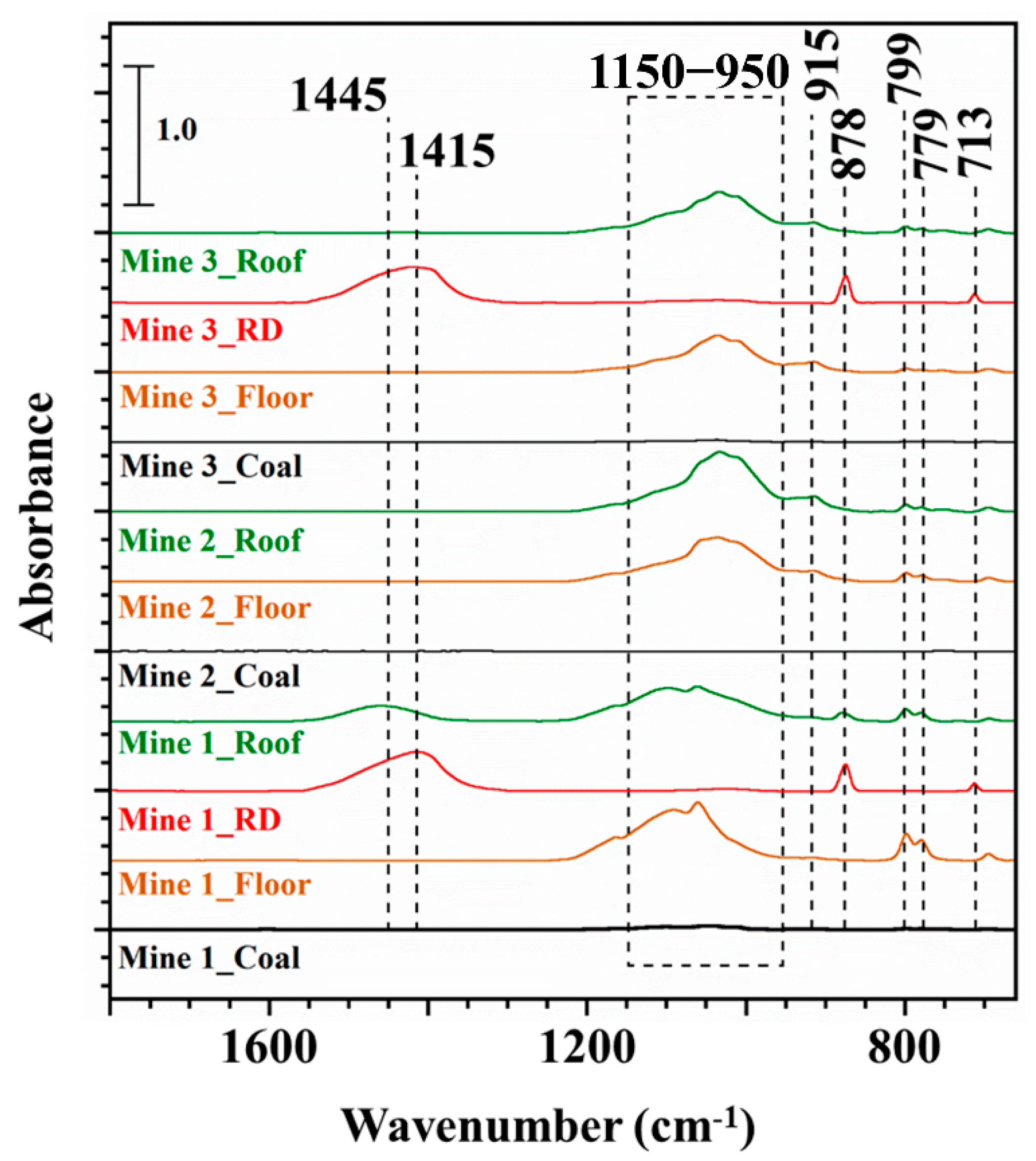
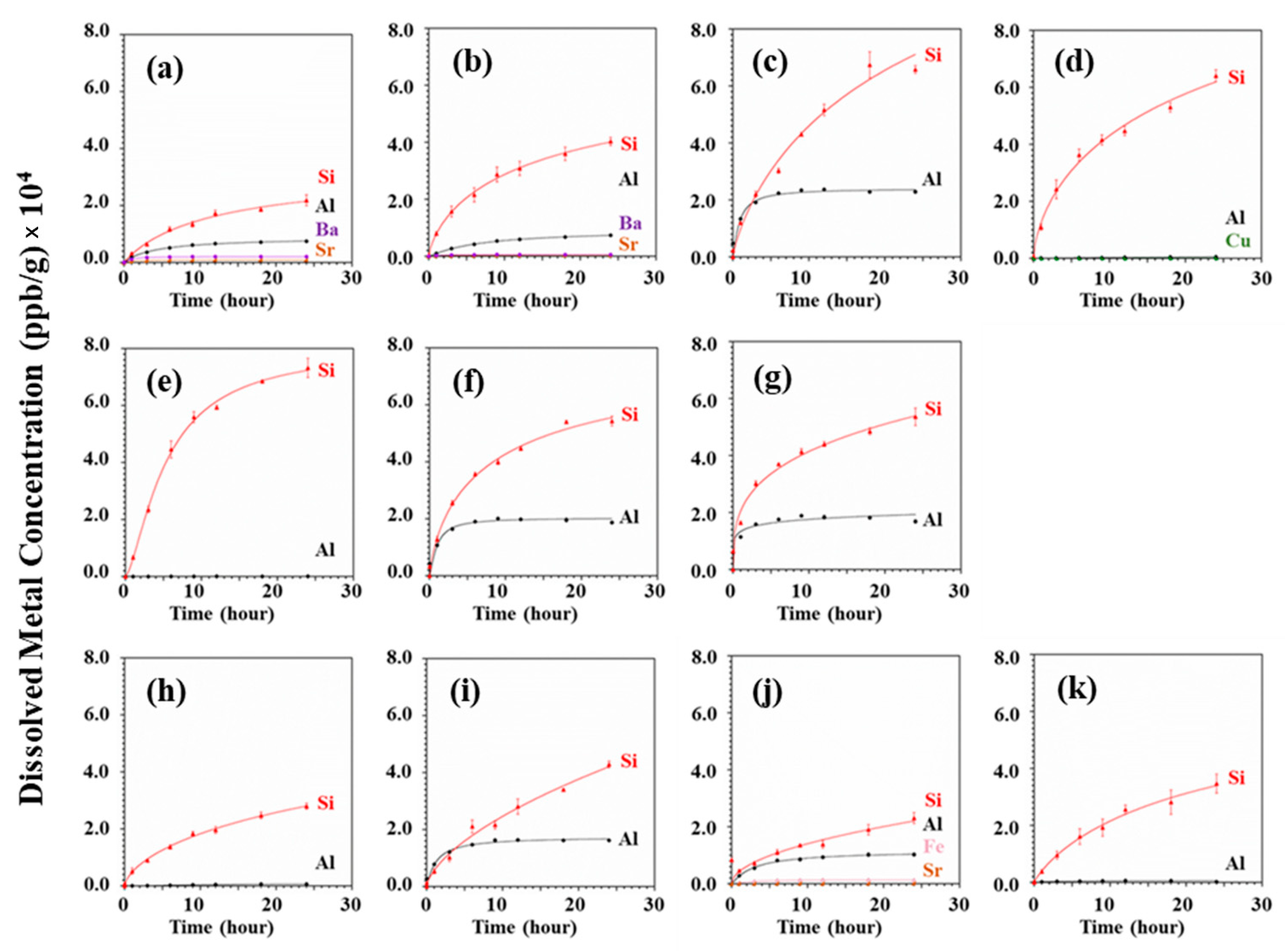

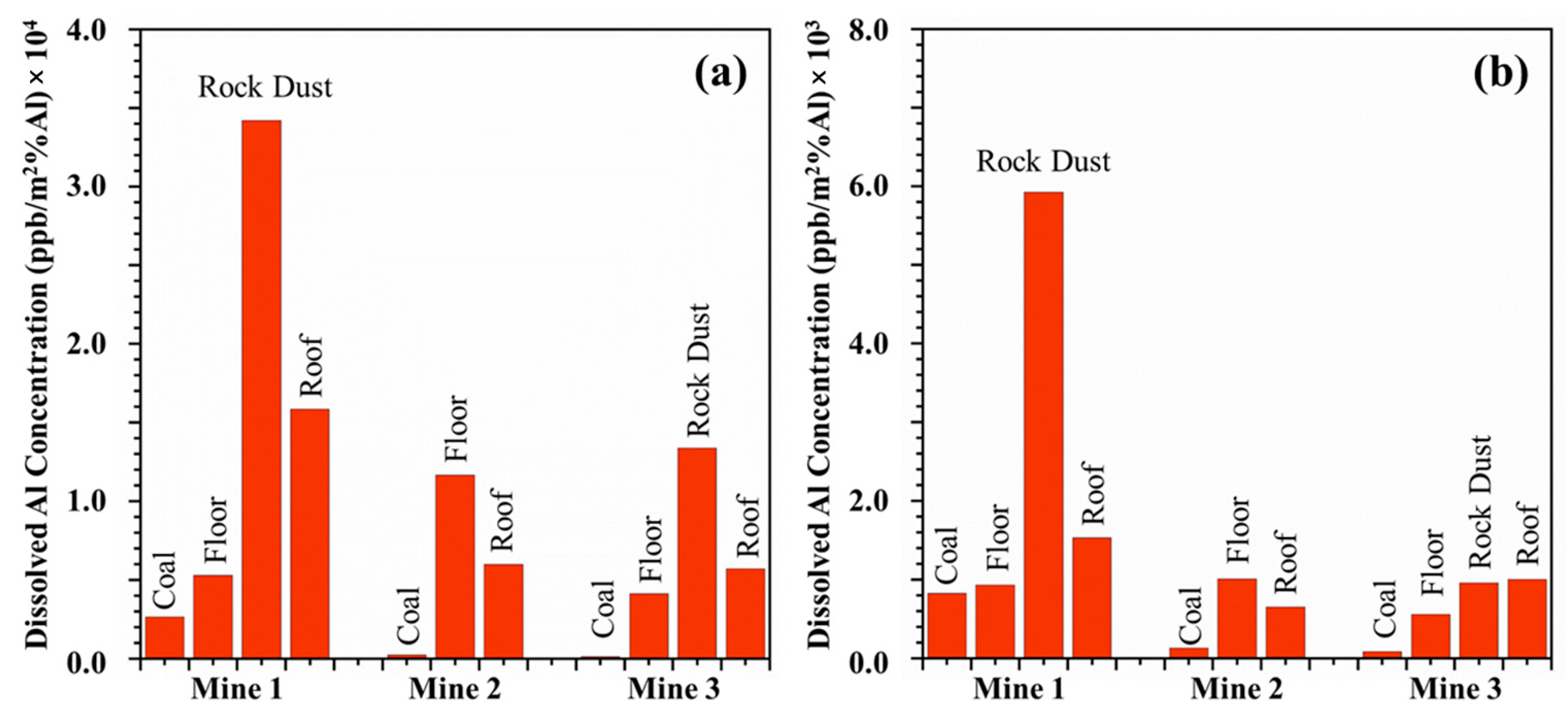
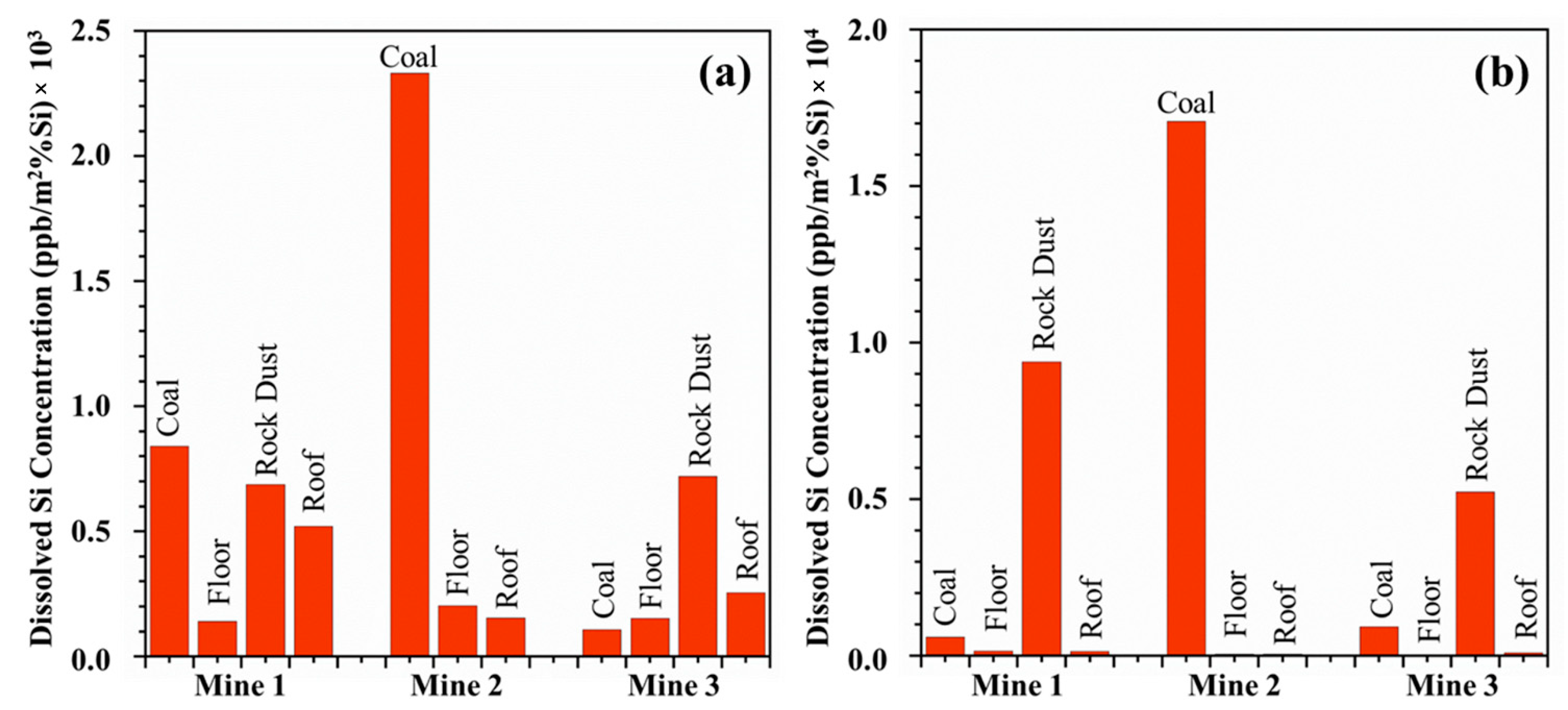

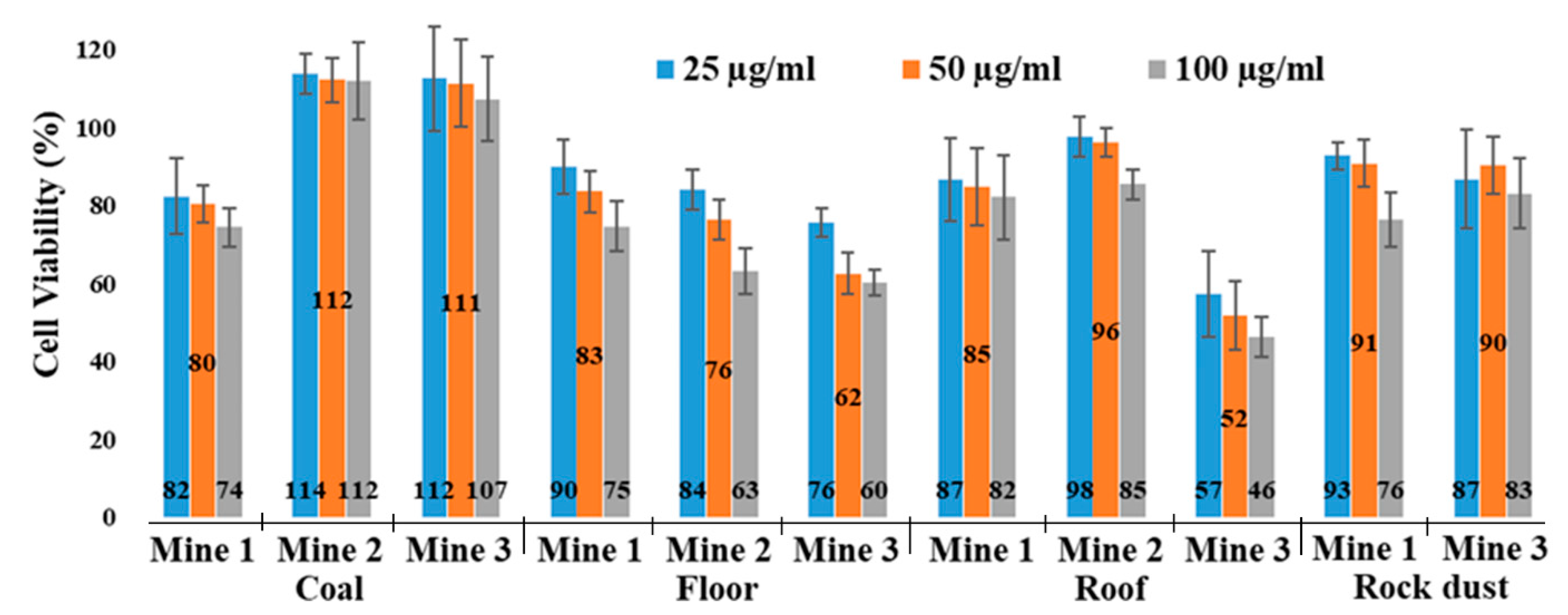

| Mine ID | Mining Method | Source | Sample ID |
|---|---|---|---|
| Mine 1 | Long wall | Coal | Mine 1_Coal |
| Continuous miner machine floor | Mine 1_Floor | ||
| Rock dust | Mine 1_RD | ||
| Continuous miner machine roof | Mine 1_Roof | ||
| Mine 2 | Room & Pillar | Coal | Mine 2_Coal |
| Host floor | Mine 2_Floor | ||
| Host roof | Mine 2_Roof | ||
| Mine 3 | Room & Pillar | Coal | Mine 3_Coal |
| Host floor | Mine 3_Floor | ||
| Rock dust | Mine 3_RD | ||
| Host roof | Mine 3_Roof |
| Sample | Average Particle Size (μm) | PM10 (%) | PM4 (%) |
|---|---|---|---|
| Mine 1_Coal | 3.36 ± 2.42 | 97.4 | 74.3 |
| Mine 1_Floor | 3.31 ± 2.74 | 97.3 | 73.5 |
| Mine 1_RD | 3.80 ± 2.13 | 98.2 | 60.3 |
| Mine 1_Roof | 2.03 ± 1.20 | 100.0 | 94.2 |
| Mine 2_Coal | 2.17 ± 1.25 | 100.0 | 91.0 |
| Mine 2_Floor | 1.79 ± 0.90 | 100.0 | 97.0 |
| Mine 2_Roof | 1.55 ± 0.94 | 100.0 | 97.8 |
| Mine 3_Coal | 2.68 ± 1.65 | 99.4 | 84.1 |
| Mine 3_Floor | 3.65 ± 2.01 | 97.8 | 70.0 |
| Mine 3_RD | 3.29 ± 1.93 | 99.5 | 71.7 |
| Mine 3_Roof | 2.55 ± 1.82 | 99.4 | 86.4 |
| Sample ID | Q | K | P | I | Mu | M | Ch | Ca | D | S |
|---|---|---|---|---|---|---|---|---|---|---|
| Mine 1_Coal | √ | √ | - | - | - | - | - | - | - | - |
| Mine 1_Floor | √ | √ | - | √ | - | √ | - | - | - | - |
| Mine 1_RD | √ | - | - | - | - | - | √ | √ | √ | - |
| Mine 1_Roof | √ | √ | - | - | √ | - | - | - | √ | √ |
| Mine 2_Coal | √ | √ | √ | - | - | - | - | √ | - | - |
| Mine 2_Floor | √ | - | - | - | √ | - | √ | √ | - | - |
| Mine 2_Roof | √ | √ | √ | - | √ | - | √ | - | - | - |
| Mine 3_Coal | √ | √ | - | - | √ | - | - | √ | √ | - |
| Mine 3_Floor | √ | √ | √ | - | √ | - | - | - | - | - |
| Mine 3_RD | √ | - | - | - | - | - | - | √ | - | - |
| Mine 3_Roof | √ | √ | √ | - | √ | - | - | - | - | - |
| Samples | AL (ppb/g) | Si (ppb/g) | Mn (ppb/g) | Fe (ppb/g) | Cu (ppb/g) | Sr (ppb/g) | Ba (ppb/g) | Pb (ppb/g) | ||||||||
|---|---|---|---|---|---|---|---|---|---|---|---|---|---|---|---|---|
| ALF | GS | ALF | GS | ALF | GS | ALF | GS | ALF | GS | ALF | GS | ALF | GS | ALF | GS | |
| Mine 1_Coal | 24,157 | 7491 | 30,628 | 21,867 | 19 | - | 2995 | - | 50 | - | 730 | 980 | 2090 | 2055 | 269 | - |
| Mine 1_Floor | 42,106 | 7395 | 38,263 | 40,324 | 46 | - | 4630 | - | 168 | - | 540 | 393 | 1399 | 561 | 32 | - |
| Mine 1_RD | 3199 | 554 | 4691 | 64,097 | 4349 | - | 6260 | - | 168 | 126 | 1289 | - | 325 | - | 1465 | - |
| Mine 1_Roof | 236,210 | 22,903 | 246,474 | 65,779 | 7381 | - | 311,387 | - | 176 | - | 879 | - | 2070 | - | 117 | - |
| Mine 2_Coal | 261 | 129 | 10,007 | 73,247 | 26 | - | 2181 | - | 699 | - | 315 | - | 272 | - | 447 | - |
| Mine 2_Floor | 216,190 | 18,717 | 195,795 | 54,311 | 671 | - | 85,658 | - | 146 | - | 299 | - | 2157 | - | 130 | - |
| Mine 2_Roof | 154,646 | 16,914 | 147,532 | 53,600 | 96 | - | 24,964 | - | 286 | - | 538 | - | 2308 | - | 108 | - |
| Mine 3_Coal | 1229 | 671 | 3213 | 27,958 | 25 | - | 9168 | - | 784 | - | 210 | - | 154 | - | 2603 | - |
| Mine 3_Floor | 119,462 | 16,223 | 133,812 | 42,885 | 101 | - | 29,332 | - | 364 | - | 790 | - | 2172 | - | 310 | - |
| Mine 3_RD | 3281 | 236 | 4769 | 34,697 | 570 | - | 2746 | - | 148 | - | 3106 | - | 33 | - | 31 | - |
| Mine 3_Roof | 58,544 | 10,277 | 64,096 | 23,090 | 367 | - | 129,782 | 1226 | 97 | - | 220 | 156 | 982 | - | 1049 | - |
Disclaimer/Publisher’s Note: The statements, opinions and data contained in all publications are solely those of the individual author(s) and contributor(s) and not of MDPI and/or the editor(s). MDPI and/or the editor(s) disclaim responsibility for any injury to people or property resulting from any ideas, methods, instructions or products referred to in the content. |
© 2023 by the authors. Licensee MDPI, Basel, Switzerland. This article is an open access article distributed under the terms and conditions of the Creative Commons Attribution (CC BY) license (https://creativecommons.org/licenses/by/4.0/).
Share and Cite
Das, M.; Salinas, V.; LeBoeuf, J.; Khan, R.; Jacquez, Q.; Camacho, A.; Hovingh, M.; Zychowski, K.; Rezaee, M.; Roghanchi, P.; et al. A Toxicological Study of the Respirable Coal Mine Dust: Assessment of Different Dust Sources within the Same Mine. Minerals 2023, 13, 433. https://doi.org/10.3390/min13030433
Das M, Salinas V, LeBoeuf J, Khan R, Jacquez Q, Camacho A, Hovingh M, Zychowski K, Rezaee M, Roghanchi P, et al. A Toxicological Study of the Respirable Coal Mine Dust: Assessment of Different Dust Sources within the Same Mine. Minerals. 2023; 13(3):433. https://doi.org/10.3390/min13030433
Chicago/Turabian StyleDas, Milton, Vanessa Salinas, Jason LeBoeuf, Rifat Khan, Quiteria Jacquez, Alexandra Camacho, Mark Hovingh, Katherine Zychowski, Mohammad Rezaee, Pedram Roghanchi, and et al. 2023. "A Toxicological Study of the Respirable Coal Mine Dust: Assessment of Different Dust Sources within the Same Mine" Minerals 13, no. 3: 433. https://doi.org/10.3390/min13030433
APA StyleDas, M., Salinas, V., LeBoeuf, J., Khan, R., Jacquez, Q., Camacho, A., Hovingh, M., Zychowski, K., Rezaee, M., Roghanchi, P., & Rubasinghege, G. (2023). A Toxicological Study of the Respirable Coal Mine Dust: Assessment of Different Dust Sources within the Same Mine. Minerals, 13(3), 433. https://doi.org/10.3390/min13030433








